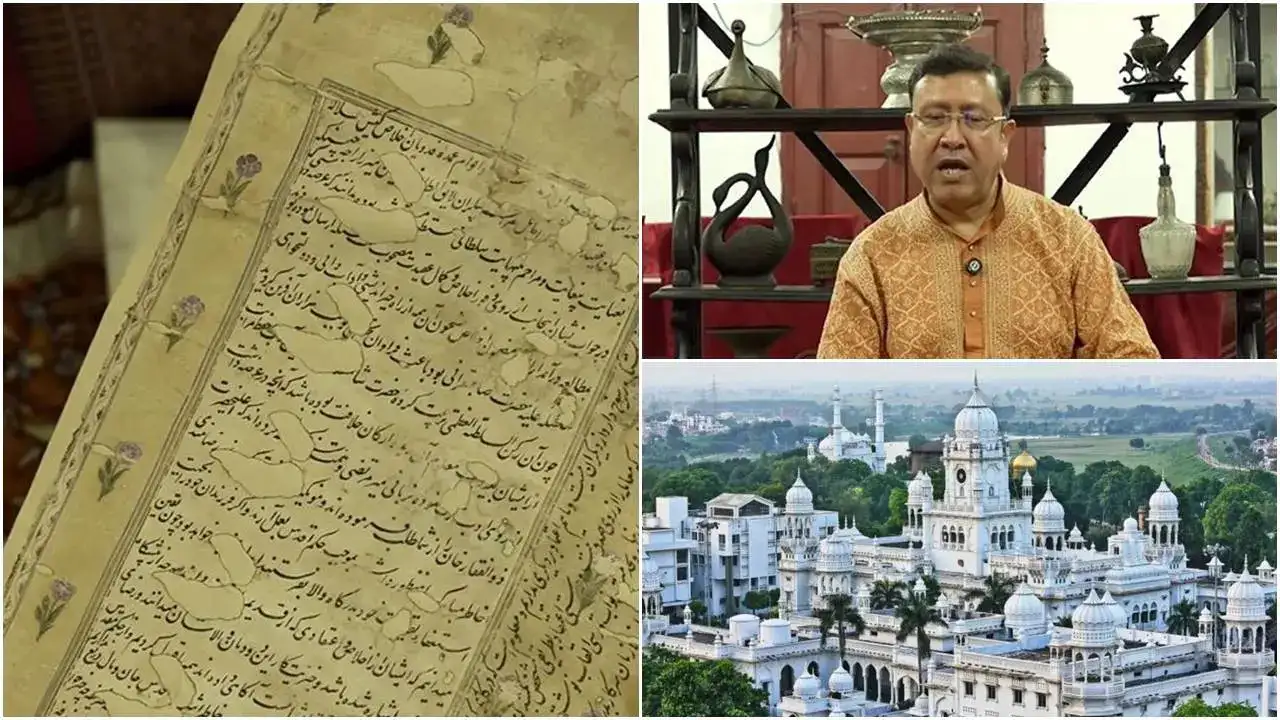Copyright timesnownews

When people think of Lucknow, they picture the dainty etiquette of the Nawabs, the grand arches of Rumi Darwaza, and kebabs so soft they practically apologise before melting in your mouth. But here’s a twist — Lucknow’s story didn’t begin with the Nawabs at all. Long before the perfumed world of tehzeeb and tahzeeb, a clan of proud warriors and administrators — the Sheikhzadas — were already setting the stage. They were the city’s first power players, the original custodians of culture, and the men who literally built its first fort. As Sheikh Aamir Raza, a descendant of the family, says: “Most of the people in Lucknow talk about the Nawabs, but no one talks about what was in Lucknow before the Nawabs. In Lucknow, before the Nawabs, there were princes here — the Sheikhzadas.” 🏰 Before The Nawabs, There Were The Sheikhzadas While the Nawabs made Lucknow elegant, it was the Sheikhzadas who made it important. Their story goes back to the 12th century, when Sheikh Adam Senani — a descendant of the famed Sufi saint Sheikh Abdul Qadir Jilani — arrived in the region. “Among the first princes to arrive was Sheikh Adam Senani,” says Raza. “And later, there was Sheikh Abdur Raheem Bin Nuri, whom Emperor Akbar sent as the Governor of Awadh.” By the Mughal era, the Sheikhzadas had become the de facto rulers of the area, serving as governors and guardians of what would one day become Awadh’s crown jewel. And then came the man himself — Sheikh Abdur Raheem Bijnori, appointed by Emperor Akbar as the first Subedar (Governor) of Awadh. He didn’t just rule Lucknow; he redefined it. 🐟 Machhi Bhawan — The Fort That Started It All One fine imperial morning, Sheikh Abdur Raheem decided Lucknow needed a fort. Not just any fort — a magnificent fortress that would command respect and serve as the city’s beating heart. “When Sheikh Abdur Raheem Bin Nuri came to Lucknow, he built a huge fort here,” says Aamir Raza. “With time, it came to be known as Machhi Bhawan.” The result? Machhi Bhawan (literally, “the fish palace”), a colossal fort with 26 gates, each ornamented with fish carvings — a symbol of good fortune and royal authority. Did you know? 🐟 The fish motif was so deeply associated with the Sheikhzadas that the Mughal court honoured Sheikh Abdur Raheem with the title ‘Mahi Maratib’ — The Order of the Fish. The emblem would later become one of the official symbols of the Nawabs of Awadh! But history can be cruel. Over centuries, the once-mighty Machhi Bhawan lost its walls to time and colonial ambition. Today, its grounds are home to King George’s Medical University (KGMU) — a place where scalpels replaced swords, and lectures echo where battle cries once rang out. “Today, instead of Machhi Bhawan, it is King George Medical College — a great medical institution,” Aamir Raza notes, with a bittersweet pride. 📜 A Trail Of Farmans And Forgotten Fortunes Sheikh Aamir Raza still guards his family’s legacy — 29 royal decrees (Farmans) issued by emperors of the Mughal court. “We have 29 royal orders,” he shares. “Akbar’s Farman — which was for our family. Shah Jahan’s order, which is also related to our family.” Imagine that — fragile paper scrolls once sealed with imperial wax, now carefully preserved in the alleys of Yahiyaganj. Each one a whisper from emperors past, confirming the Sheikhzadas’ role not just as rulers, but as the Mughal Empire’s most trusted custodians in Awadh. 🐎 The Day They Saved An Emperor The Sheikhzadas’ loyalty wasn’t limited to paper. They showed it when Emperor Humayun lost to Sher Shah Suri and fled Delhi — humiliated, weary, and desperate. As Aamir Raza recounts: “जब शेरशाह सूरी से हुमायूं को हार हुई और वो दिल्ली से अपनी जान बचाकर भागे, तो लखनऊ से होते हुए वो गए। उस ज़माने में लखनऊ के शेhzदों ने उनकी 50 घोड़ों से और Rs 10,000 से मदद करी।” (When Humayun was defeated by Sher Shah Suri and fled Delhi to save his life, he passed through Lucknow. The Sheikhzadas helped him with 50 horses and Rs 10,000.) A forgotten act of loyalty that perhaps saved a dynasty — talk about an early example of Lucknowi mehmaan-nawaazi (hospitality)! ⚔️ The Clash With Bijli Pasi Before the Sheikhzadas, Lucknow was ruled by Bijli Pasi, a fierce chieftain descended from the legendary warrior brothers Alha and Udal. When the Sheikhzadas arrived with Mughal backing, a battle for control was inevitable. The clash between Pasi’s local fort and Sheikhzada ambition marked Lucknow’s first great power struggle. The Sheikhzadas emerged victorious — transforming Lucknow from a regional outpost into a Mughal stronghold. That victory didn’t just change rulers; it changed the destiny of the city. 🕋 Nadan Mahal — The Resting Place Of Lucknow’s First Governor The Sheikhzada legacy isn’t entirely lost. Walk through Yahiyaganj, and you’ll find Nadan Mahal, the tomb of Sheikh Abdur Raheem Bijnori — a red sandstone structure, beautifully austere, with Quranic verses still glinting in the fading sun. “His resting place is famous as Nadan Mahal,” says Aamir Raza. Why Nadan? Local legend says the Sheikhzadas were known for their innocence and humility. People lovingly called them “Nadan” — meaning innocent. Hence, the mausoleum came to be known as Nadan Mahal, the Tomb of the Innocent. Even today, it’s one of Lucknow’s oldest Mughal-era structures, quietly preserved under the Archaeological Survey of India. 🧭 From Machhi Bhawan To Machhi Manzil — The Echoes Of Legacy While Machhi Bhawan was the Sheikhzadas’ fortress of power, the later Machhi Manzil — built during the Nawabi era — took its name as a nostalgic tribute to that lost fort. The ruins of Machhi Manzil still carry whispers of the Sheikhzada era, bridging the city’s two golden chapters — the age of the warriors and the age of the aesthetes. And if you walk through the lanes near KGMU or Yahiyaganj today, you’ll notice — beneath the sound of rickshaw bells and kebab skewers sizzling — a quiet hum of forgotten glory. Lucknow’s Sheikhzada era is the prologue to its Nawabi splendour. They were the city’s first urban planners, builders, and defenders — men who brought Mughal grace to the Gomti plains long before velvet sherwanis and ittar bottles arrived. 🧩 Did You Know? The Machhi (fish) emblem seen across Lucknow — from crests to palace gates — predates the Nawabs; it originated with Sheikhzada heraldry. The British demolished Machhi Bhawan in 1858 after the Revolt, fearing it would become a rebel fortress. Nadan Mahal is one of Lucknow’s oldest surviving Mughal tombs. Some Sheikhzada families still preserve swords and royal Farmans dating back to Emperor Akbar’s reign. Lucknow, it seems, was always destined for grandeur. But before the Nawabs painted it in poetry and perfume, the Sheikhzadas laid its foundations in stone and strength. So, the next time you stroll past KGMU or glimpse a fish emblem carved on an old gate — remember, you’re walking through the echoes of the Sheikhzadas who dreamt Lucknow first. Travel News - Find latest news and tips based on Indian and World travel including top 10 travel destination, tourism information, how to reach visit and more at Times Now.



